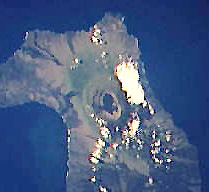|
Description of the Galapagos Islands Volcan Wolf  | | A satelite view of Volcan Wolf. Picture source: http://www.geo.cornell.edu/geology/GalapagosWWW/VolcanWolf.jpg |
Volcan Wolf, located at the northeast end of the island of Isabela (also known as Albarmarle Island) is the highest volcano in the Galapagos, reaching an elevation of over 1700 meters (5600 feet). Like the other western volcanoes, it has a large caldera. Volcan Wolf's caldera is slightly elongate in a NW-SE direction, measuring 5 by 7 km, and, with a depth of 600 m, it is the second deepest in the Galapagos. Volcan Wolf is among the most active volcanos in the Galapagos. The caldera floor is covered with young lava and many young flows may be seen on its flanks, particularly on the eastern side. Ten historic eruptions have been documented between 1797 and 1982. The 1982 eruption was particularly spectacular: fountains of lava emenating from a vents in the caldera floor rose above the caldera rim. Because of its steep slopes, most of the lavas on Wolf are of the aa type, making the climb to the summit a difficult one.
The distribution of vents on Volcan Wolf is typical of that of the western volcanoes. Vents are aligned along circumferential fissures on the summit plateau. On the flanks, however, most vents are aligned along radial fissures. A particularly active ESE-WNW aligned fissure zone connects Volcan Wolf to its western neighbor, Volcan Ecuador, which is much smaller. Although they abut each other, Volcan Wolf and Volcan Ecuador differ markedly in the composition of their lavas, particularly in trace element and isotopic composition. There is also a clear distinction in lava chemistry between Wolf and its southern neighbor, Volcan Darwin (although less marked than that between Wolf and Ecuador). In terms of isotopic composition, Volcan Wolf is quite unusual becuase isotope ratios are more similar to lavas erupted at mid-ocean ridges than those erupted at other oceanic islands. It shares this trait with several other Galapagos volcanoes, most notably Santa Cruz and Genovesa.
Until very recently, the remoteness and steepness of Volcan Wolf had kept its biota relatively insulated from the effects of man and the animals he brought. However, the area is now threatened by the invasion of feral goats that is effecting most of northern Isabela and is most severe on Alcedo. Goats were first reported on Wolf in 1995. Goats devestate the natural flora, thereby threating the native herbivores such as the land iguana and giant tortoise.
|







